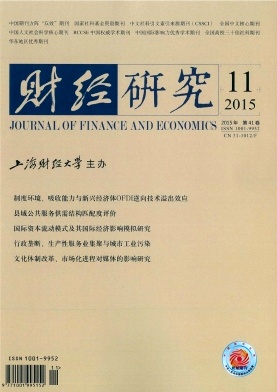国际资本流动模式及其国际经济影响模拟研究
财经研究 2015 年 第 41 卷第 11 期, 页码:58 - 70
摘要
参考文献
摘要
国际资本流动是影响世界经济格局的重要因素,对中国未来的经济发展和在世界经济体系中的地位也起着关键性的作用。文章构建了一个经济一体化格局下包含创新机制的多国多部门的一般均衡模型,设计了两种国际资本流动模式,对不同国际资本流动模式驱使下各主要国家经济发展和产业分工格局进行了模拟。研究发现:(1)当前国际资本流动模式是介于投资回报率均衡模式和资本吸引力模式之间的混合模式,这种情景将使中国、印度等发展中国家获得较高的经济增长速度;(2)在混合模式情景下,各部门都存在产业重心从发达国家向发展中国家转移的趋势,劳动力密集型产业的转移幅度普遍高于资本密集型产业;(3)国际资本流动模式的改变对国家间经济关系和经济地位的变化具有显著影响:当国际资本流动完全遵循投资回报率均衡时,资本更倾向于流动到具有较大市场规模的发达国家,而当国际资本完全按照资本吸引力流动时,资本倾向于流动到发展中国家,而发达国家可能出现"再工业化"的现象。由于三种情景下均将长期处于资本净流出状态,中国需要制定合理的政策措施,对资本流动进行引导,提高资本吸收能力,突破当前国际资本流动格局的束缚。
[1] 鲍银胜, 刘国平. 购买力平价理论在国际经济发展中的运用缺陷及其改进对策[J]. 国际金融研究, 2013, (9): 56-63.
[2] 路风, 余永定. "双顺差"、能力缺口与自主创新——转变经济发展方式的宏观和微观视野[J]. 中国社会科学, 2012, (6): 91-114.
[3] 王铮, 葛昭攀, 廖悲雨. 知识溢出下增长收敛的复杂性[J]. 财经研究, 2007, (10): 131-143.
[4] 温建东. 人民币购买力平价研究[J]. 金融研究, 2005, (4): 44-56.
[5] 余永定. 全球不平衡条件下中国经济增长模式的调整[J]. 国际经济评论, 2007, (1): 5-11.
[6] Alfaro L, Kalemli-Ozcan S, Volosovych V. Why doesn't capital flow from rich to poor countries? An empirical investigation [J]. The Review of Economics and Statistics, 2008, 90(2): 347-368.
[7] Backus D K, Kehoe P J, Kydland F E. Dynamics of the trade balance and the terms of trade: The J-Curve? [J]. American Economic Review, 1994, 84 (1): 84-103.
[8] Bosworth B P, Collins S M, Reinhart C M. Capital flows to developing economies: Implications for saving and investment [J]. Brookings Papers on Economic Activity, 1999, 1999(1): 143-180.
[9] Caniëls M C J, Verspagen B. Barriers to knowledge spillovers and regional convergence in an evolutionary model [J]. Evolutionary Economics, 2001, 11(3): 307-329.
[10] Cheng S. How can western China attract FDI? A case of Japanese investment[J]. The Annals of Regional Science, 2008, 42(2): 357-374.
[11] Devereux M B, Sutherland A. A portfolio model of capital flows to emerging markets[J]. New Approaches to Financial Globalization, 2008, 89(2): 181-193.
[12] Feldstein M. Domestic saving and international capital movements in the long run and the short run [J]. European Economic Review, 1983, 21(1-2): 157-159.
[13] Jin K. Industrial structure and capital flows [J]. American Economic Review, 2012, 102(5): 2111-2146.
[14] Lucas R E. Why doesn't capital flow from rich to poor [J]. The American Economic Review, 1990, 80(2):92-96.
[15] Ma G, Yi W. China's high saving rate: Myth and reality[J]. International Economics, 2010, 122(2):5-39.
[16] Tille C, van Wincoop E. International capital flows [J]. Journal of International Economics, 2010, 80(2): 157-175.
[17] Wang Z, Gu G, Wu J, et al. CIECIA: A new climate change integrated assessment model and its assessments of global carbon abatement schemes [J]. Science China: Earth Sciences, accepted, 2015.
[18] Warnock F E, Warnock V C.International capital flows and U.S. interest rates [J]. Journal of International Money and Finance, 2009, 28(6): 903-919.
[2] 路风, 余永定. "双顺差"、能力缺口与自主创新——转变经济发展方式的宏观和微观视野[J]. 中国社会科学, 2012, (6): 91-114.
[3] 王铮, 葛昭攀, 廖悲雨. 知识溢出下增长收敛的复杂性[J]. 财经研究, 2007, (10): 131-143.
[4] 温建东. 人民币购买力平价研究[J]. 金融研究, 2005, (4): 44-56.
[5] 余永定. 全球不平衡条件下中国经济增长模式的调整[J]. 国际经济评论, 2007, (1): 5-11.
[6] Alfaro L, Kalemli-Ozcan S, Volosovych V. Why doesn't capital flow from rich to poor countries? An empirical investigation [J]. The Review of Economics and Statistics, 2008, 90(2): 347-368.
[7] Backus D K, Kehoe P J, Kydland F E. Dynamics of the trade balance and the terms of trade: The J-Curve? [J]. American Economic Review, 1994, 84 (1): 84-103.
[8] Bosworth B P, Collins S M, Reinhart C M. Capital flows to developing economies: Implications for saving and investment [J]. Brookings Papers on Economic Activity, 1999, 1999(1): 143-180.
[9] Caniëls M C J, Verspagen B. Barriers to knowledge spillovers and regional convergence in an evolutionary model [J]. Evolutionary Economics, 2001, 11(3): 307-329.
[10] Cheng S. How can western China attract FDI? A case of Japanese investment[J]. The Annals of Regional Science, 2008, 42(2): 357-374.
[11] Devereux M B, Sutherland A. A portfolio model of capital flows to emerging markets[J]. New Approaches to Financial Globalization, 2008, 89(2): 181-193.
[12] Feldstein M. Domestic saving and international capital movements in the long run and the short run [J]. European Economic Review, 1983, 21(1-2): 157-159.
[13] Jin K. Industrial structure and capital flows [J]. American Economic Review, 2012, 102(5): 2111-2146.
[14] Lucas R E. Why doesn't capital flow from rich to poor [J]. The American Economic Review, 1990, 80(2):92-96.
[15] Ma G, Yi W. China's high saving rate: Myth and reality[J]. International Economics, 2010, 122(2):5-39.
[16] Tille C, van Wincoop E. International capital flows [J]. Journal of International Economics, 2010, 80(2): 157-175.
[17] Wang Z, Gu G, Wu J, et al. CIECIA: A new climate change integrated assessment model and its assessments of global carbon abatement schemes [J]. Science China: Earth Sciences, accepted, 2015.
[18] Warnock F E, Warnock V C.International capital flows and U.S. interest rates [J]. Journal of International Money and Finance, 2009, 28(6): 903-919.
引用本文
顾高翔, 王铮. 国际资本流动模式及其国际经济影响模拟研究[J]. 财经研究, 2015, 41(11): 58–70.
导出参考文献,格式为:





 6686
6686  2849
2849

